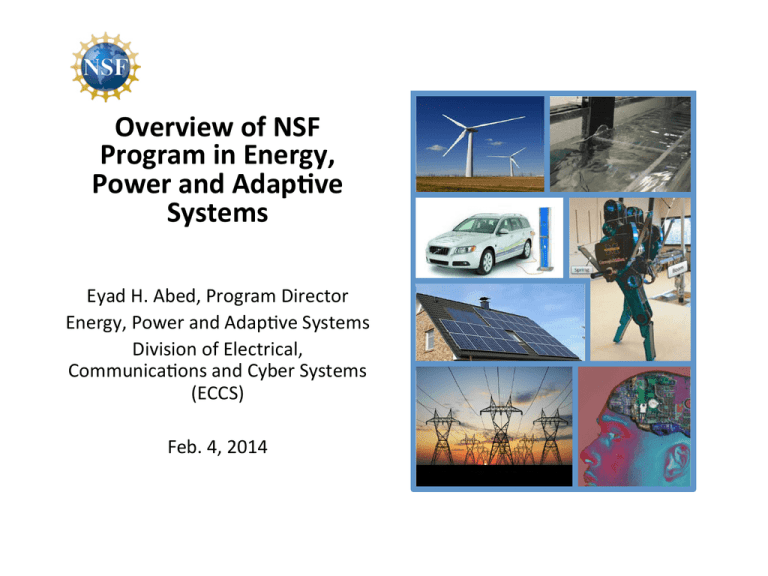Document 11345597
advertisement

Overview of NSF Program in Energy, Power and Adap8ve Systems Eyad H. Abed, Program Director Energy, Power and Adap8ve Systems Division of Electrical, Communica8ons and Cyber Systems (ECCS) Feb. 4, 2014 Outline § § § § § § NSF’s Role in Research and Educa8on Energy, Power, and Adap8ve Systems (EPAS) Program The Evolving Grid – Renewables and Smart Grid Cyber Physical Systems (CPS) Interagency Funding Examples Conclusions NSF’s Role in Research and Educa8on • NSF is an independent federal agency established in 1950 • Supports fundamental research and educa8on in science and engineering • NSF has a discipline-­‐based structure with cross-­‐ disciplinary mechanisms • Uses “rotators” or IPA’s as well as permanent program directors • FY’14 NSF budget is $7.17B ($5.81B for research, of which about $800M is in the Engineering Directorate) Energy, Power, and Adap8ve Systems (EPAS) Program • I recently took an IPA posi8on as a Program Director in the EPAS Program at NSF • EPAS is the program within ECCS (Electrical, Communica8ons and Cyber Systems Division) that supports power and energy systems and technologies as well as systems and control • EPAS has 3 Program Directors -­‐-­‐-­‐ 2 permanent and 1 rotator • EPAS leverages other programs in NSF (and other agencies) whenever possible Energy, Power, and Adap8ve Systems (EPAS) Kishan Bahe8 Eyad Abed Paul Werbos § Control Theory & Hybrid Dynamical Systems § Distributed & Mobile Networked Control § Networked Sensing & Imaging Systems § Control Aspects of Cyber-­‐ Physical Systems § Cyber Secure Control of Power Systems § Systems Theory in Molecular, Cellular, & Synthe8c Biology § Networked Robo8cs & Transporta8on Networks § Energy Collec8on & Harves8ng Devices and Systems § Energy Storage § Advanced Power Electronics § Electric Grid Interfaces § Electric & Hybrid Vehicles § Energy/Power Sensing § Local Distributed Power Systems § Adap8ve & Intelligent Systems § Transmission & Distributed Systems § Intelligent Power Grid & Economics § Quantum Systems & Modeling § Theory and Modeling for Systems & Devices § Neuromorphic Engineering § Cogni8ve Op8miza8on & Predic8on § Intelligent Vehicles § Learning & Intelligence for Robo8cs 5 Energy, Power, and Adap8ve Systems (EPAS) • Design and analysis of complex systems including sensing, imaging, control and computa8onal technologies • Emphasis on electric power networks including genera8on, transmission, distribu8on • Power electronics and drives • Energy harves8ng devices and systems • Regulatory and economic structures Energy, Power, and Adap8ve Systems (EPAS) • Types of Proposals – Faculty Early Career Development (CAREER) – Single Inves8gators / Small group – Industry Collabora8ons (GOALI) – Exploratory Research (EAGER) – Workshops in emerging areas – Interna8onal collabora8ons – REU, RET (students, teachers) – Other NSF solicita8ons (ERC, STC, IUCRC, CPS, …) Energy, Power, and Adap8ve Systems (EPAS) • Guidance in Preparing Proposals – Propose your fundamental ideas that you feel can advance the art over the medium to long term – NSF wants to support researchers to make fundamental advances – Some prior work helps to convince panels of project feasibility – Unsolicited proposals are all due in November of each year – Special programs have different deadlines (or are open) The Evolving Grid – Renewables and Smart Grid • Producing electricity contributes 40% of world carbon dioxide emissions • Electricity use in the U.S. is expected to double by mid-­‐ century • The electric power industry is now undergoing significant change, some of which is mo8vated by environmental considera8ons (this is tradi8onally a conserva8ve industry) • Incorpora8on of renewable power sources is increasing worldwide • Development of the Smart Grid is also occurring to obtain efficiencies and protect the environment The Evolving Grid – Renewables and Smart Grid • Many fundamental issues need to be addressed as renewable penetra8on increases: – How to build out renewables to maintain system reliability, stability, etc. – Advanced storage technologies – Effect of renewables on u8li8es – including economic fairness • Smart Grid also brings up new research issues, including modeling human behavior and response to incen8ves; gaming; etc • Anyway, the research community will discover and address these problems; NSF is here to help evaluate and support the research Vision of Cyber-­‐Enabled Mega-­‐scale Power Grid: Informa8on Network Overlay Power System DER-­‐ Distributed Energy Resources 11 Smart Grid Framework 12 NSF AWARD SEARCH • www.nsf.gov – Search awards • Advanced search – Program officer • Many op8ons available – Program Informa8on – Keyword search “power Systems” “power Electronics” “Energy Harves8ng”… Interagency Funding Examples 16 Electrical Energy Systems Educa8on with Emphasis on Sustainable Power (ECCS-­‐ 0901635/1028326, Mohan, University of Minnesota – Twin CiFes) (Supported by NSF, NASA, ONR, DOE and EPRI) Vision: Revitalizing Electric Energy Systems Educa8on worldwide through proac8ve dissemina8on and the Internet using CUSP™ 80-­‐Universi8es DOE Consor8um Outcomes: § Power & Energy Curriculum § Undergraduate & Graduate Courses § Workshops § Laboratories § Student Enrollment § Published Textbooks Professor Ned Mohan University of Minnesota CURENT(Center for Ultra-­‐Wide-­‐Area Resilient Electric Energy Transmission Networks, Tomsovic, University of Tennessee, Knoxville) (Supported by NSF and DOE) A na8on-­‐wide or con8nent-­‐wide transmission grid that is fully monitored and dynamically controlled in real-­‐8me for high efficiency, high reliability, low cost, beNer accommoda8on of renewable energy sources, full u8liza8on of energy storage, and accommoda8on of responsive load. A new genera8on of electric power and energy systems engineering leaders with global perspec8ves and diverse backgrounds. Interna8onal Partner Universi8es: Na8onal Technical University of Athens Tsinghua University University of Waterloo Affiliate Universi8es: Federal University of Rio de Janeiro Montana Tech Supelec Tennessee State University Tuqs University University of California, Santa Barbara SunShot Ini8a8ve $145M for Advanced Solar Technologies F-­‐PACE (Founda8onal Program to Advance PV Cell Efficiency) • DOE/SETP & NSF/ECCS • (18 Projects/$38.5M) • Awarded FY2012 Conclusions • This is an exci8ng 8me to be involved in advancing research and educa8on in electric energy systems • NSF offers seed funding for fundamental research through unsolicited grants and other mechanisms • NSF’s goal is to use its resources to support development of the most promising ideas • I am available at eabed@nsf.gov; ; feel free to contact me 20





